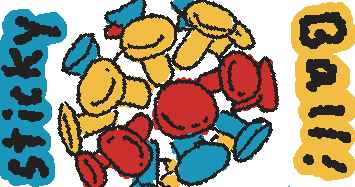Sticky Ball Games
Teachers who find themselves pressed for time will find this little ball covered in suctions cups to be a surprisingly flexible and effective tool.
Is your class starting in a few minutes and you just want to find a game to play? Click HERE to skip to the games.
What’s a sticky ball?
The apply-named sticky ball is a small plastic toy ball that is covered in tiny suction cups that allows it to stick to hard, smooth surfaces when thrown at them. They are quite cheap and ubiquitous in English cram schools around eastern Asia.
Are sticky ball games worth playing?
For any given topic, for any given class, there are an infinite number of activities that you could come up with. Ideally you would be given ample time and resources to prepare and your co-teachers would offer you help and advice. As years pass you’d refine your lessons and expertly adapt them to the unique needs of each class. You may very well reach the peak of pedagogy without ever bringing a sticky ball into your classroom.
But in reality, particularly in cram schools, you’re may find yourself with possibly only minutes to prepare, with scarce resources, and instructions from your boss to teach pages from a book you’re not familiar with to classes of students that change from week from week. In that kind of situation you may genuinely have only the humble sticky ball as the one and only toy in the classroom.
What games can I play?
The simple action of throwing a sticky ball at a target, usually a whiteboard, lends itself to a variety of games that can make class time fun and engaging. Here’s a list of games I have played with my students with brief descriptions. Each link leads to a more detailed article.
Sticky Dash is a fast-paced team game that spices up what would otherwise be rote repetition.
Sticky Match (coming soon) is a quick team game about matching words with definitions.
Sticky Bingo adds an element of skill to traditional bingo.
Sticky Math (coming soon) is a slower-paced game about careful aim and math skills.
Typhoon is a slower-paced game where accuracy is paramount. It’s mostly just for fun though.
More games are coming soon!
Games to avoid
Basic games that involve little more than throwing a sticky ball at a facsimile of a dart board are seldom a good use of class time. They may get students excited briefly, but they’ll quickly lose interest, especially if you try to play day after day. At best this game can help with numeracy, but if that’s the lesson you’re trying to teach, then I have better games for you.
Considerations
- Don’t set up situations where students are in the line of fire.
- Be careful not to get hit yourself.
- Targets can be any shape or size.
- Very young students, or students with limited mobility, need special consideration when creating targets for them to throw at. Any target will need to be large, but targets that are higher than their heads will need to be larger still. It’s easier to vary aim horizontally than vertically, so for my youngest students I draw a few very large targets in one horizontal line.
- Have a plan for when the sticky ball hits outside of the play area. In my classes I usually proceed as if the ball had hit the nearest valid target.
- Also have a plan for when the ball lands on the border of two targets. I usually pick the one that would the most advantageous for the thrower.
- Always have extra sticky balls handy in case a throw goes wild and a ball comes to rest under a dusty cabinet or something. Stopping to retrieve it mid-game interrupts the flow of class.
- Although sticky ball games are best suited to elementary-aged students, even teenagers will find the occasional game a welcome, if somewhat silly, diversion.
